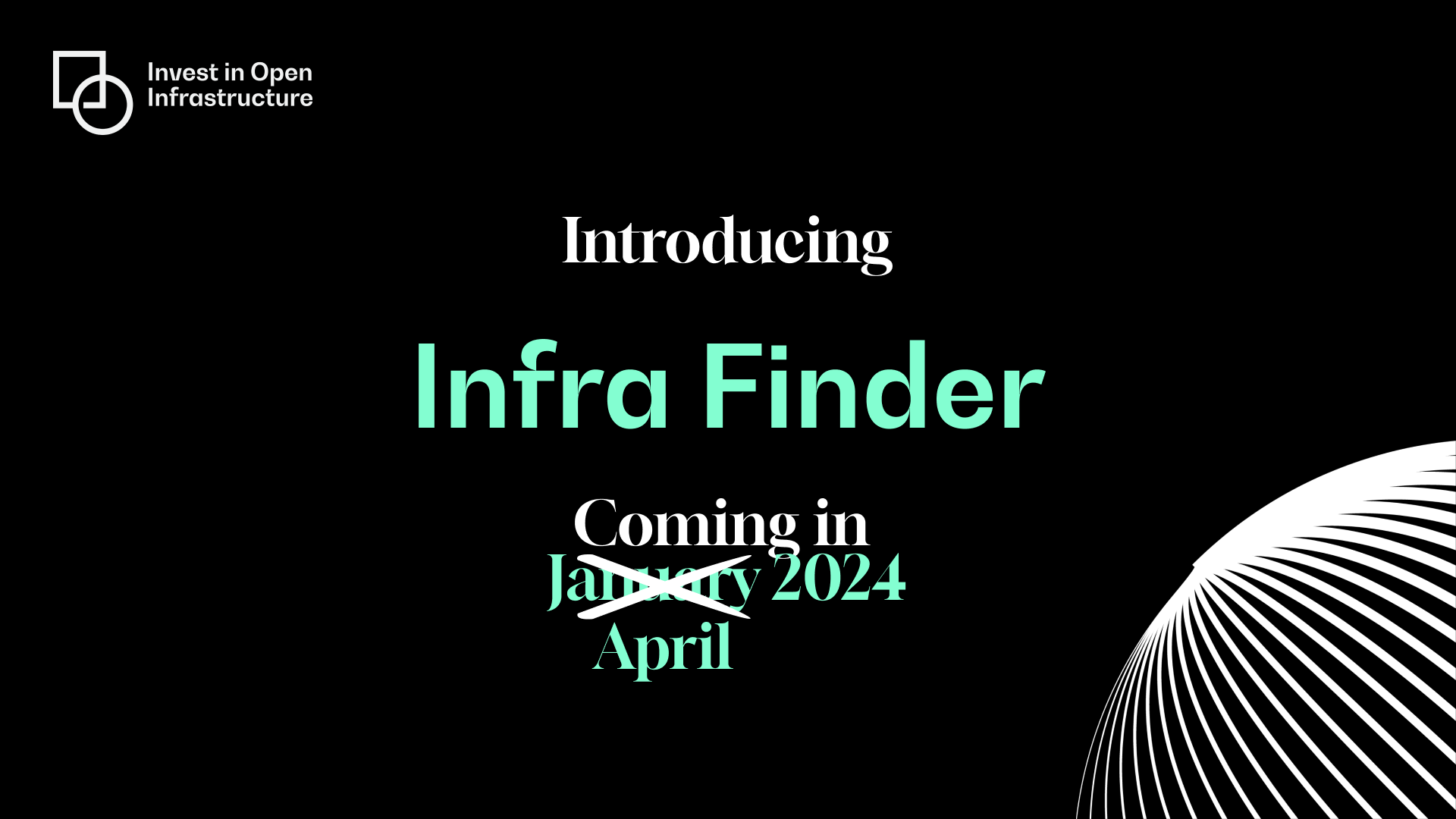
Note: This post was updated on January 30, 2024, to reflect a new timeline for Infra Finder. Please see our update post here.
We have been hard at work on the next phase of our solutions-focused efforts to increase adoption of and investment in open infrastructure. Today, we are happy to share an update about our work so far to develop IOI’s new tool, Infra Finder.
To recap our path: After collectively developing and launching the Catalog of Open Infrastructure Services pilot project in 2022 and learning from our community, the whole of IOI realized we needed to re-envision what outcomes we could affect and rethink what solutions could look like. From a policy standpoint, we wanted to further the aims of UNESCO’s Recommendation on Open Science, which sets an intention that “access to scientific knowledge should be as open as possible” and emphasizes: “The world needs open science now.” We also knew that infrastructure and information and communications technology is a key part of the United Nations’ Sustainable Development Goal 9. In addition, the US government published the Nelson memo, which calls for an update to public access policies for Federal funders “no later than December 31st, 2025.” In looking to prior and existing efforts, we consulted and sought inspiration from works including the Principles of Open Scholarly Infrastructure, the Scholarly Communication Technology Catalogue, and the HELIOS Scholarly Communication Infrastructure Guide.
To ensure that what we’re building will be useful for the community we want it to serve, we conducted user research, interviews with infrastructure service providers, focus group discussions, and user testing to refine the understanding of the problem we’re addressing. A key theme came to the fore: Leaders of libraries and research institutions were looking for open infrastructures that could enable the sharing of scholarly output in a way that advances their institution’s vision for “open”. We therefore wanted to build a tool that could help decision makers in libraries and research institutions discover the services and resources that could help them — one that could grow and evolve with the needs of the research environment. We focused our first invitations to infrastructure service providers on those that support open content and data repositories, along with the services that expressed their interest in participating when we launched the pilot in 2022.
Building on existing resources and user research findings, we redesigned the infrastructure intake form, asking questions on topics like technology infrastructure, history, organizational structure, finances, and community engagement that both enables infrastructures to showcase their achievements and meet users’ needs in discovery and evaluation. To ensure that we can provide high-quality, verified information in a scalable manner, we also developed a robust data collection and validation process. We will have a lot more to say on the design of Infra Finder and our data collection at launch, but we wanted to share this preview before the end of the year.
We invited 84 service providers to participate, and received responses from 56 services as of the date of this post. We are thankful to those service providers for not only responding to our form, but also for providing valuable feedback and additional information through interviews, comments, and questions during the process. We made a number of updates along the way in response to this feedback, and using the knowledge gained from this first iteration, we plan to develop a new intake form that providers can use in the future to nominate themselves for inclusion in our tool.
While we were collecting this information, we also conducted user testing to understand how different people might approach a tool like Infra Finder, and refined the utility of the tool. From these tests and interviews, we understand that our users see this tool as a way to start a number of conversations — about potential infrastructures to support a service or program, about gaps in services or synergies between them, and about essential funding to sustain the open infrastructure ecosystem. We are excited to build a tool that lets users find, discover, and compare open infrastructures. We also think there will be plenty of inspiration to be found in the information contained in Infra Finder, and we are eager to explore these with the community.
This is the first iteration — it’s a beginning, not the final nor the end. We’re looking to use this to share some of what we’ve learnt and been thinking about, and to spark conversations around how IOI, in partnership with our communities of practice, can increase investment in and adoption of open infrastructure. We also acknowledge that Infra Finder will not be comprehensive at launch — there are certainly many more than 56 open infrastructures that the research world relies on! We are planning to include new services in our tool and at launch, we will include a form for infrastructure providers to express their interest in being included.
What can you expect next? Right now (December 2023), we’re processing the information gathered and finalizing our designs and data. We will launch Infra Finder in April 2024 (postponed from our original launch date of January 2024), along with an Expression of Interest form that service providers can use to indicate their interest in being part of the next group of infrastructures to be listed.
We will be attending a lot of conferences, both virtual and in person, to demonstrate this tool and get more feedback. We’ll let you know where we will be, so you can meet us! The best way to stay up-to-date is to sign up for our newsletter and follow us on social media (LinkedIn, Mastodon, X/Twitter).